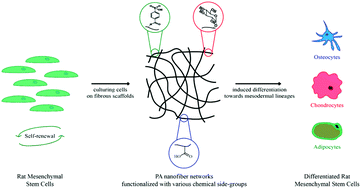Presentation of functional groups on self-assembled supramolecular peptide nanofibers mimicking glycosaminoglycans for directed mesenchymal stem cell differentiation†
Abstract
Organizational complexity and functional diversity of the extracellular matrix regulate cellular behaviors. The extracellular matrix is composed of various proteins in the form of proteoglycans, glycoproteins, and nanofibers whose types and combinations change depending on the tissue type. Proteoglycans, which are proteins that are covalently attached to glycosaminoglycans, contribute to the complexity of the microenvironment of the cells. The sulfation degree of the glycosaminoglycans is an important and distinct feature at specific developmental stages and tissue types. Peptide amphiphile nanofibers can mimic natural glycosaminoglycans and/or proteoglycans, and they form a synthetic nanofibrous microenvironment where cells can proliferate and differentiate towards different lineages. In this study, peptide nanofibers were used to provide varying degrees of sulfonation mimicking the natural glycosaminoglycans by forming a microenvironment for the survival and differentiation of stem cells. The effects of glucose, carboxylate, and sulfonate groups on the peptide nanofibers were investigated by considering the changes in the differentiation profiles of rat mesenchymal stem cells in the absence of any specific differentiation inducers in the culture medium. The results showed that a higher sulfonate-to-glucose ratio is associated with adipogenic differentiation and a higher carboxylate-to-glucose ratio is associated with osteochondrogenic differentiation of the rat mesenchymal stem cells. Overall, these results demonstrate that supramolecular peptide nanosystems can be used to understand the fine-tunings of the extracellular matrix such as sulfation profile on specific cell types.



 Please wait while we load your content...
Please wait while we load your content...